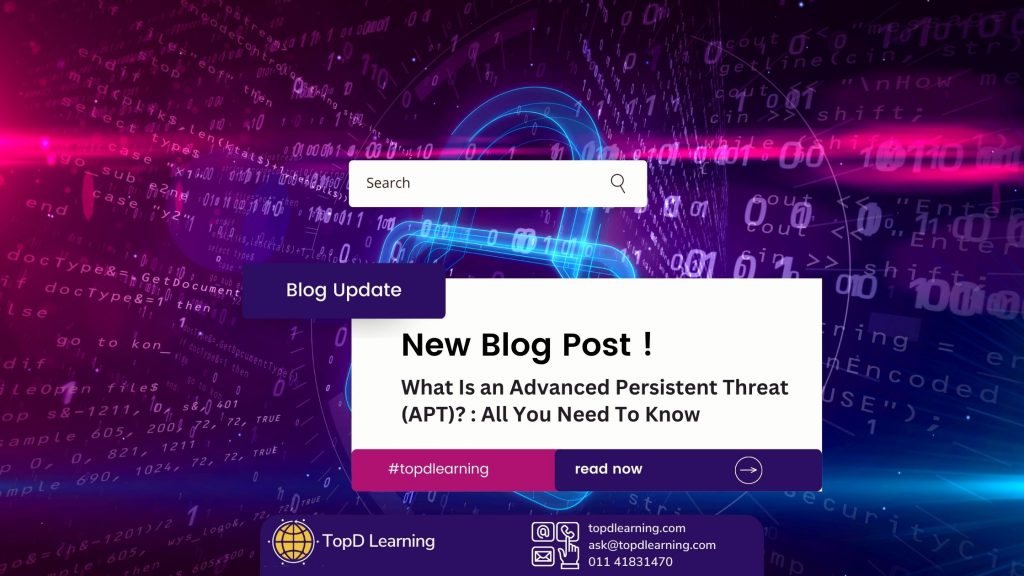Unravel the enigma of Advanced Persistent Threats in this TopD Learning’s blog post, and learn how a robust cybersecurity strategy can protect your organization from APTs and other insidious cyber threats.
Introduction
In the ever-changing digital landscape, businesses and organizations face a growing variety of cyber threats. Among these, Advanced Persistent Threats (APTs) stand out as highly sinister and potentially devastating cyber-attacks. Orchestrated by resourceful and skilled adversaries, often state-sponsored or connected to organized cybercriminal groups, APTs employ long-term, sophisticated strategies designed to fly under the radar, wreaking havoc on an organization’s reputation, finances, and operations.
Grasping the nature of APTs and devising efficient countermeasures is of utmost importance. In this blog post, we’ll dissect APTs by delving into their defining features, identifying their stages and techniques, discussing mitigation strategies and response plans, and emphasizing the significance of a comprehensive cybersecurity approach to fend off APTs and other cyber threats. By the end of this read, you’ll be well-equipped to fortify your organization against these elusive cyber adversaries.
Table of Content
- Decoding Advanced Persistent Threats (APTs)
- Identifying APT Attack Stages and Techniques
- Mitigating and Responding to APTs
- The Importance of a Comprehensive Cybersecurity Strategy
Main Content
1. Decoding Advanced Persistent Threats (APTs)
APTs are a unique breed of cyber threats, displaying distinct traits that set them apart from other attacks. Key attributes of APTs include:
- Long-term campaigns: APTs involve protracted, coordinated attacks on precise targets, often lasting months or even years. These relentless attackers patiently probe for vulnerabilities, exploiting them to retain access to the target network.
- Stealthy and sophisticated techniques: APT actors utilize advanced tactics to circumvent traditional security measures, often deploying custom-built malware, zero-day exploits, and encryption to cloak their activities.
- Highly targeted attacks: Unlike more indiscriminate cyber threats, APTs focus on specific organizations or individuals, leveraging deep insights into their target’s networks, systems, and operations to craft tailored attack campaigns.
2. Identifying APT Attack Stages and Techniques
An APT attack typically follows a defined life cycle, consisting of multiple stages:
- Initial compromise: Attackers gain a foothold in the target network, often through spear-phishing emails or by exploiting software or hardware vulnerabilities.
- Establishing foothold: After the initial compromise, attackers install malware or create backdoors to maintain persistent access to the compromised system.
- Gaining privileges: APT actors escalate their privileges within the target network, enabling them to access sensitive data or control vital systems.
- Lateral movement: Attackers traverse the target network, compromising additional systems and gathering intel on the organization’s infrastructure.
- Data exfiltration: Once the attackers achieve their objectives, they extract sensitive information from the compromised systems, often employing encryption or other methods to avoid detection.
APTs deploy a variety of techniques to infiltrate and maintain access to target networks:
- Spear-phishing emails: Targeted, fraudulent emails sent to specific individuals, containing malicious attachments or links that, when opened, compromise the recipient’s device.
- Exploit kits: Prepackaged sets of tools and scripts designed to exploit software or hardware vulnerabilities, allowing APT actors to infiltrate target networks.
- Watering hole attacks: In this approach, attackers compromise a website frequented by the target organization’s employees, injecting malicious code that infects visitors’ devices.
- Supply chain attacks: Attackers compromise a third-party vendor or service provider to gain access to the target organization’s systems, leveraging the trust established between the parties.
3. Mitigating and Responding to APTs
Organizations must employ a multifaceted approach to combat APTs effectively. Key strategies include:
- Regular risk assessments: Conducting thorough risk assessments helps identify vulnerabilities in your organization’s systems and processes, enabling the implementation of appropriate countermeasures.
- Patch management: Staying up-to-date on software and hardware updates is crucial in thwarting APT actors who exploit known vulnerabilities.
- Network segmentation: Dividing your organization’s network into smaller, isolated sections can prevent APT actors from moving laterally and accessing sensitive data.
- Employee training: Educating employees on APTs, cyber threats, and safe online practices is essential for reducing the risk of successful spear-phishing or other social engineering attacks.
- Incident response plan: Establishing a clear, actionable plan for detecting, containing, and recovering from APT attacks can minimize the damage and help restore normal operations.
4. The Importance of a Comprehensive Cybersecurity Strategy
A robust cybersecurity strategy is the cornerstone of defending against APTs and other cyber threats. Components of an effective strategy include:
- Advanced threat detection: Employing advanced security tools, such as machine learning-based intrusion detection systems, can help identify anomalous network activity indicative of APTs.
- Threat intelligence: Gathering and sharing information on emerging cyber threats can improve your organization’s preparedness and ability to react to APTs.
- Multi-factor authentication (MFA): Implementing MFA adds an extra layer of security, reducing the risk of unauthorized access to your organization’s systems.
- Regular backups: Routinely backing up critical data and systems can facilitate recovery in the event of an APT attack or other cyber incidents.
- Collaboration with law enforcement: Engaging with local and national law enforcement agencies can help track down and deter APT actors, while also benefiting from shared knowledge and resources.
Conclusion
APTs represent a significant and growing threat to organizations worldwide, requiring a deep understanding of their characteristics, attack stages, and techniques. By implementing a comprehensive cybersecurity strategy that incorporates risk assessments, employee training, advanced detection tools, and an incident response plan, your organization can fortify its defenses against these insidious cyber adversaries. Stay vigilant, stay informed, and safeguard your digital assets from APTs and other cyber threats.
To further strengthen cybersecurity knowledge and skills, consider enrolling in TopD Learning’s CyberSecurity training courses, which are designed to equip professionals with the latest strategies and best practices for combating cyber threats. By staying informed and adapting to new challenges, organizations can build resilience and ensure their long-term success in the face of an increasingly complex and dynamic threat environment.


